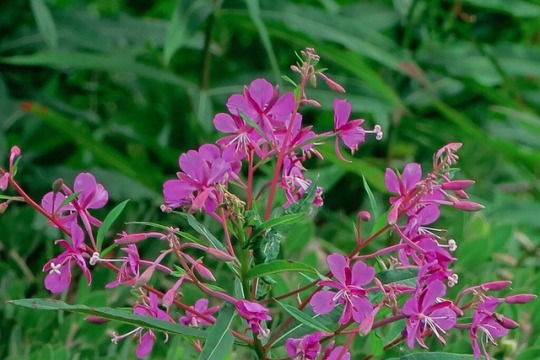#Chamerion angustifolium circumvagum
Explore tagged Tumblr posts
Video
J20170803-0075—Chamerion angustifolium—RPBG—DxO by John Rusk Via Flickr: Chamerion angustifolium ssp. circumvagum—fireweed. The species was known until 1999 as Epilobium angustifolium. Fireweed is widespread throughout the northern hemisphere. It is the floral emblem of Yukon, Canada and (as rosebay willowherb) the county flower of London, England. The common name derives from the fact that it is a fire follower, often covering immense areas in the first years following a forest fire.This plant is included whenever you see a photo of colorful wildflowers from Alaska or Newfoundland or, indeed, northern climes throughout the world. The subspecies circumnagum is the sole taxon of fireweed found in California. Photographed at Regional Parks Botanic Garden located in Tilden Regional Park near Berkeley, CA.
#DxO Fuji Velvia 50 preset#ebparksok#taxonomy:kingdom=Plantae#Plantae#taxonomy:subkingdom=Tracheophyta#Tracheophyta#taxonomy:phylum=Magnoliophyta#Magnoliophyta#taxonomy:class=Magnoliopsida#Magnoliopsida#taxonomy:order=Myrtales#Myrtales#taxonomy:family=Onagraceae#Onagraceae#taxonomy:genus=Chamerion#Chamerion#taxonomy:species=angustifolium#taxonomy:binomial=Chamerion angustifolium#taxonomy:trinomial=Chamerion angustifolium circumvagum#Chamerion angustifolium circumvagum#fireweed#CHAANGCI#épilobe vagabond#taxonomy:common=fireweed#taxonomy:common=CHAANGCI#taxonomy:common=épilobe vagabond#Epilobium angustifolium
1 note
·
View note
Photo










Lake Molkomssjön, Sweden (No. 2)
The reddish stems of this herbaceous perennial are usually simple, erect, smooth, 0.5–2.5 m (1½–8 feet) high with scattered alternate leaves. The leaves are spirally arranged, entire, narrowly lanceolate, and pinnately veined, the secondary leaf veins anastomosing, joining together to form a continuous marginal vein just inside the leaf margins.
The inflorescence is a symmetrical terminal raceme that blooms progressively from bottom to top, producing a gracefully tapered shape. The flowers are 2 to 3 cm in diameter, slightly asymmetrical, with four magenta to pink petals and four narrower pink sepals behind. The protruding style has four stigmas.
The upright, reddish-brown linear seed capsule splits from the apex and curls open. It bears many minute brown seeds, about 300 to 400 per capsule and 80,000 per plant. The seeds have silky hairs to aid wind dispersal and are very easily spread by the wind, often becoming a weed and a dominant species on disturbed ground. Once established, the plants also spread extensively by underground roots, an individual plant eventually forming a large patch.
This species has been placed in the genus Chamaenerion (sometimes given as Chamerion) rather than Epilobium based on several morphological distinctions: spiral (rather than opposite or whorled) leaf arrangement; absence (rather than presence) of a hypanthium; subequal stamens (rather than stamens in two unequal whorls); zygomorphic (rather than actinomorphic) stamens and stigma. Under this taxonomic arrangement, Chamaenerion and Epilobium are monophyletic sister genera.
Two subspecies are recognized as valid:
Chamaenerion angustifolium subsp. angustifolium
Chamaenerion angustifolium subsp. circumvagum
Source: Wikipedia
#Lake Molkomssjön#Värmland County#Karlstad Municipality#water#woods#forest#fireweed#wildflower#reed#grass#flora#lake shore#vacation#summer 2019#original photography#tourist attraction#travel#landscape#countryside#Sweden#Sverige#Scandinavia#Northern Europe#tree#birch#I really love the first pic
4 notes
·
View notes
Video
J20160616-0007—Chamerion angustifolium ssp. circumvagum—RPBG by John Rusk Via Flickr: Chamerion angustifolium ssp. circumvagum—fireweed. The species was known until 1999 as Epilobium angustifolium. Fireweed is widespread throughout the northern hemispere. It is the floral emblem of Yukon, Canada and (as rosebay willowherb) the county flower of London, England. The common name derives from the fact that it is a fire follower, often covering immense areas in the first years following a forest fire.This plant is included whenever you see a photo of colorful wildflowers from Alaska or Newfoundland or, indeed, northern climes throughout the world. The subspecies circumnagum is the sole subspecies found in California. Photographed at Regional Parks Botanic Garden located in Tilden Regional Park near Berkeley, CA.
#ebparksok#taxonomy:kingdom=Plantae#Plantae#taxonomy:superphylum=Tracheophyta#Tracheophyta#taxonomy:phylum=Magnoliophyta#Magnoliophyta#taxonomy:class=Magnoliopsida#Magnoliopsida#taxonomy:order=Myrtales#Myrtales#taxonomy:family=Onagraceae#Onagraceae#taxonomy:genus=Chamerion#Chamerion#taxonomy:species=angustifolium#taxonomy:binomial=Chamerion angustifolium#taxonomy:trinomial=Chamerion angustifolium circumvagum#Chamerion angustifolium circumvagum#fireweed#CHAANGCI#épilobe vagabond#taxonomy:common=fireweed#taxonomy:common=CHAANGCI#taxonomy:common=épilobe vagabond
0 notes
Photo

J20170803-0075—Chamerion angustifolium—RPBG—DxO Chamerion angustifolium ssp. circumvagum—fireweed. The species was known until 1999 as Epilobium angustifolium. Fireweed is widespread throughout the northern hemisphere. It is the floral emblem of Yukon, Canada and (as rosebay willowherb) the county flower of London, England. The common name derives from the fact that it is a fire follower, often covering immense areas in the first years following a forest fire.This plant is included whenever you see a photo of colorful wildflowers from Alaska or Newfoundland or, indeed, northern climes throughout the world. The subspecies circumnagum is the sole taxon of fireweed found in California. Photographed at Regional Parks Botanic Garden located in Tilden Regional Park near Berkeley, CA.
1 note
·
View note

